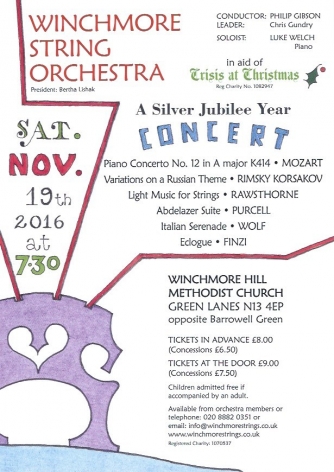Details
Winchmore Hill Methodist Church
Green Lanes
Enfield
London
N13 4EP
England
Programme
Alan Rawsthorne – Light Music for Strings
Wolfgang Amadeus Mozart – Piano Concerto no.12 in A major, K.414/385p
Henry Purcell – Abdelazer, Z.570
~ Interval ~
Hugo Wolf – Italian Serenade
Gerald Finzi – Eclogue for piano and strings, Op.10
Nikolay Rimsky-Korsakov – Variations on a Russian Theme in G major (Various)
Performers
Luke Welch – piano
Winchmore String Orchestra
Other concerts in this Series (+)
Programme Note
BY ARRANGEMENT
String orchestras are a bit like children in thrifty households: they don’t often get a new outfit, but they do very well with hand-me-downs and second-hand clothes altered to fit them. In the case of string orchestras, the amount of music written specifically for them is not large – compared, say, to symphony orchestras or chamber groups – but they have a rich repertoire of pieces written for other purposes and re-tailored to suit them.
In our next concert – the final one in our Silver Jubilee year – we have decided to showcase some such pieces. These will illustrate the often unsung art of “arrangement” – re-working music written in one musical genre for another and sometimes as a result becoming better-known and loved than the original. A refined form of re-cycling,
One of the commonest forms of arrangement is from string quartet to string orchestra; not surprisingly, since both have the same combination of instruments -- first and second violins, violas and cellos, plus doublebasses in the orchestra. An example in our concert is the Italian Serenade by Hugo WOLF, who died tragically young early last century. This lively piece was originally planned to be one movement in a suite for string quartet, and was called simply Serenade in G, but later it was left to stand alone, with Italian added to the title. Our solo work – MOZART’s Piano Concerto No 12 (soloist Luke Welch) also exists in two scorings. It is one of three piano concertos Mozart wrote in his mid-20s with two versions of the accompaniment – one for orchestra including wind and horns as normal, the other for string quartet – probably because the composer thought that would be more likely to sell better.
But, there are many kinds of arrangement, as out concert will show. It opens with Light Music for Strings by the British composer Alan RAWSTHORNE. Written in 1938 and based on three Catalan tunes, it reflects his sympathy with the Republican cause in the Spanish Civil War. Similarly originating in folk music are the Variations on a Russian Theme by a group of Russian composers including RIMSKY-KORSAKOV. The pensive Eclogue for piano and strings by Gerald FINZI was originally meant to be part of a full piano concerto, while PURCELL’s Abdelazer Suite sees the arrangement process the other way around – as you will hear if you know Benjamin Britten’s Young Person’s Guide to the Orchestra.

 Your events at Classical Events
Your events at Classical Events

